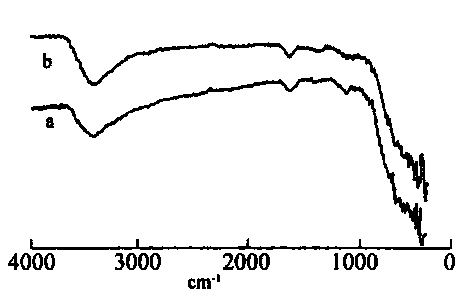Preparation method of antibacterial nano material
A nano-material and nano-iron technology, applied in the field of nano-materials, can solve problems such as insufficient atomic coordination, small diameter of nano-titanium dioxide particles, and reduced antibacterial properties of nano-materials
- Summary
- Abstract
- Description
- Claims
- Application Information
AI Technical Summary
Problems solved by technology
Method used
Image
Examples
Embodiment 1
[0028] A preparation method of antibacterial nanomaterials, the preparation steps are as follows:
[0029] 1) Add the adhesive polyethylene glycol and polycarbonate diol into the vacuum reactor, heat and stir evenly, the heating temperature in the vacuum reactor is 130°C, the stirring time is 16 min, and the stirring speed is 700r / min After the stirring is completed, the temperature of the solution is lowered to 41°C, and after dehydration treatment in a vacuum reactor for 1 hour, the product A is obtained;
[0030] 2), adding spherical glass microspheres, silver oxide, and polyhexamethylguanidine stearate into the vacuum reactor containing the product A, fully stirring evenly, the stirring time is 8min, and the stirring speed is 700r / min, After stirring evenly, carry out vacuum treatment under heating. The heating temperature is 97°C and the vacuum degree is -0.08MPa. N-methyldiethanolamine, reacted for 2h to obtain product B;
[0031] 3) Mixing nano-iron-titanium dioxide c...
Embodiment 2
[0035] A preparation method of antibacterial nanomaterials, the preparation steps are as follows:
[0036] 1) Add the adhesive polyethylene glycol and polycarbonate diol into the vacuum reactor, heat and stir evenly, the heating temperature in the vacuum reactor is 135°C, the stirring time is 18min, and the stirring speed is 700r / min. After the stirring is completed, the temperature of the solution is lowered to 43°C, and after dehydration treatment in the vacuum reactor for 1.1h, the product A is obtained;
[0037]2) Add spherical synthetic silica, silver oxide, and polyhexamethylguanidine stearate into a vacuum reactor containing product A, and stir well and evenly. The stirring time is 9 minutes, and the stirring speed is 700 r / min. After uniformity, vacuum treatment is carried out in a heated state. The heating temperature is 98°C and the vacuum degree is -0.08MPa. After vacuum treatment, the temperature is lowered to 59°C. N-methyldiethanolamine, reacted for 2.5h to obta...
Embodiment 3
[0042] A preparation method of antibacterial nanomaterials, the preparation steps are as follows:
[0043] 1) Add the adhesive polyethylene glycol and polycarbonate diol into the vacuum reactor, heat and stir evenly. The heating temperature in the vacuum reactor is 140°C, the stirring time is 21min, and the stirring speed is 700r / min. After the stirring is completed, the temperature of the solution is lowered to 46°C, and after dehydration treatment in the vacuum reactor for 1.2 hours, the product A is obtained;
[0044] 2), adding spherical erucamide, silver oxide, and polyhexamethylguanidine stearate into the vacuum reactor containing the product A, fully stirring evenly, the stirring time is 10min, and the stirring speed is 700r / min, After stirring evenly, carry out vacuum treatment under heating. The heating temperature is 100°C, and the vacuum degree is -0.08MPa. Add N-methyldiethanolamine, react for 3h, and obtain product B;
[0045] 3) Mixing nano-iron-titanium dioxid...
PUM
 Login to View More
Login to View More Abstract
Description
Claims
Application Information
 Login to View More
Login to View More - R&D
- Intellectual Property
- Life Sciences
- Materials
- Tech Scout
- Unparalleled Data Quality
- Higher Quality Content
- 60% Fewer Hallucinations
Browse by: Latest US Patents, China's latest patents, Technical Efficacy Thesaurus, Application Domain, Technology Topic, Popular Technical Reports.
© 2025 PatSnap. All rights reserved.Legal|Privacy policy|Modern Slavery Act Transparency Statement|Sitemap|About US| Contact US: help@patsnap.com



